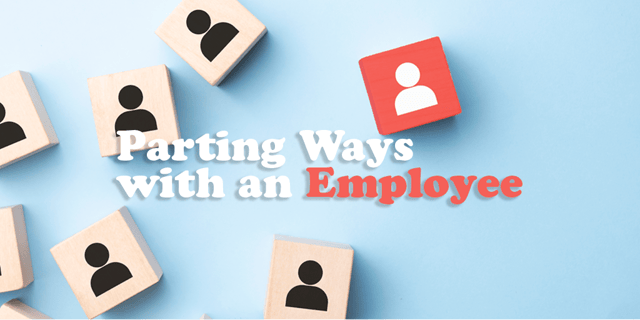Making the decision to part ways with an employee—especially in the midst of a labor shortage—is not easy. But, it may be the right one. You need team members you can rely on. Team members who work well with the team and serve your customers well. When that alignment doesn’t exist, you may need to protect your team, your customers, and your business by making a very hard and emotional decision to part ways.
If you’re wondering whether or not it’s time to part ways with an employee, here are the considerations to keep in mind.
Spotting red flags
If your employee exhibits one or more of the following traits, it may be a sign that it's time to part ways.
Absenteeism
Does your employee often come to work late or not show up at all? Perhaps they have an explanation every time. While the first few times may be excusable, continued tardiness negatively impacts the team and the individual’s performance. This is behavior that shouldn’t be condoned.
Poor attitude
Some employees may express disinterest in learning or following processes. Maybe they shrug it off with, "I'm just not good with change." This attitude is detrimental to your business. Your team is only as strong as its weakest link, and that employee will eventually drag it down—either by creating more work for the team or by setting the wrong tone.
Excuses
An employee who is constantly blaming their poor results on the company systems or their colleagues instead of proactively finding solutions to solve the problem is potentially throwing up a red flag. This is especially so if they are the only employee with such an issue, while their teammates are consistently able to meet or exceed performance expectations.
Argumentative
When an employee constantly picks fights with you or their fellow teammates or is uncooperative, it could result in low morale for the entire team. It may not be worth running the risk of having more unhappy employees. Constant disagreement with co-workers can lead to higher turnover.
Badmouthing
Is your employee often found badmouthing supervisors or being the ringleader of office gossip? When the employee is sowing discord and blatantly showing dislike toward the company's initiatives and project requirements, they may influence and encourage those around them to do the same.
Poor productivity and morale
Is your employee constantly producing low-quality output, excessively asking other teammates for help, or causing workflow delays? Not only does this affect how the team works together, but it also impacts the customer experience.
Complaints from customers and vendors
Experiencing a high volume of complaints that trace back to a single employee? You ultimately answer to your customers and vendors, so if you're experiencing poor work quality, you need to begin asking yourself how to part ways with an employee. Word of mouth from a bad experience could be detrimental to your business
Violation of Company Policies
The most prominent red flag is when an employee violates company policies. When they're constantly breaking rules, or worse, committing criminal violations, it’s a sure sign that it's time to let them go.
Terminating an Employee
Once you’ve identified the signs and have decided that the best path forward is termination, here are a few things you should do.
Start with Performance Reviews
First, be clear about the reasons behind the termination. Prior to reaching this point, you should have been having regular performance reviews to correct attitudes and behaviors and give the employee a chance to improve. These performance reviews are a great way to document progress (or lack thereof).
Take Legal Considerations
Before the termination, go through the employee’s contract to determine if there are any legal implications to consider. Do you have to give them a month's notice? Can it be an immediate termination? Ensure that you're parting ways on legal grounds, not as an act of discrimination, for example. To play it extra safe, you may want to consult an attorney.
Create a Transition Plan
A transition plan consists of two parts: ensuring that the workload is covered and determining when to break the news. The first step is critical. You’ll want to make sure you have a plan in place to cover the workload so your current team doesn’t feel overwhelmed.
When it comes to breaking the news, find a time and a place that will create the least amount of disruptions to your customers and employees.
Plan What You’ll Say
When the employee fails to show effort and/or improvement, it's time to part ways. Give a lot of thought to the words you’ll use to break the news. Words can be taken out of context, so be very clear and empathetic in your communications.
Plan ahead for any questions (ie. When can I expect my last paycheck? When does my insurance stop?) the employee might ask so you can respond with well-thought answers and set them up for an easy transition).
Have a Witness
It’s best to invite someone from HR to be present. If you have a small company, a trusted manager or employee works too. Having a witness is especially important because they will be able to vouch and validate the conversation. In circumstances where the employee has a history of violent or aggressive tendencies, you may even consider hiring a police escort to keep all parties safe.
Don't Humiliate the Employee
Each employee should still be treated with respect and dignity, regardless of the circumstance. This means having a conversation with them behind closed doors, without sounding condescending or demeaning throughout the process. By keeping things calm and respectful, you will also avoid affecting the morale of other employees.
Break the News
Start by explaining the reasons behind the termination, but avoid justifying these with phrases like, "You should have known."
Be direct, and get to the point by referring to employment in the past tense, such as "has been terminated" rather than "will be terminated." You don't want to give them false hope, or openings to negotiate otherwise. Avoid words like "I understand how you feel" to soften the blow; it may only make matters worse. Instead, listen to what they have to say. You can end by saying, “I’m sorry we have to part our ways.”
Ensure that all grounds are covered, such as references, current projects, and their benefits.
Tell Your Employees
Address the news with your employees early, but only after the employee has been formally let go. Give them an update on the changes, particularly as it relates to workload and the possible role opening, to avoid gossip and speculation. Being honest (without oversharing details) and forthcoming with employees about the changes will help you maintain trust. It is best to be transparent about the reasons you had to part ways with the employee.
Keeping Your Team Strong
When an employee creates a difficult work environment, the best thing you can do for your team—and for the team member—is to part ways. It’s much better for everyone to backfill one role than to replace an entire team. Your employees will recognize that you had their best interest in mind and your customers will appreciate the quality standard you maintain.
Looking for more ways to find quality candidates to fill your open roles? Schedule a call with us to find out how.








































